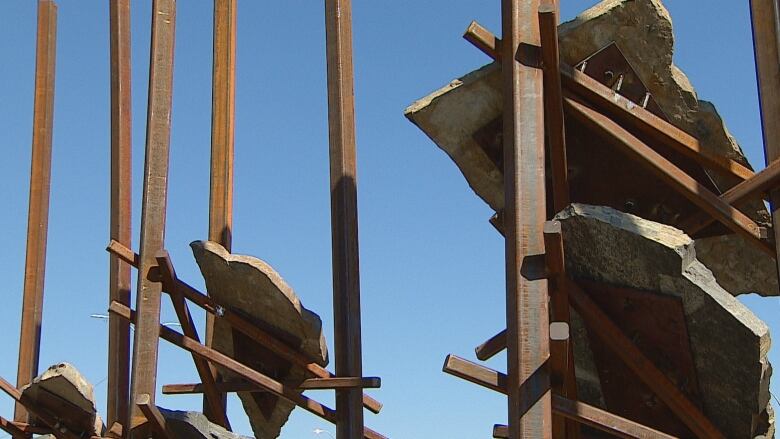Blackfoot artists call Calgary art installation 'theft of culture'
Say city should have hired local, not New Yorker, to depict Indigenous symbolism

Artists from the three Blackfoot nations of Siksika, Piikani and Kanai in Alberta sent a collective letter to the city of Calgary's Public Art Program about its controversial Bowfort Towers art installation last Thursday.
The group is requesting "adetailed account of the process and reasoning behind supporting this particular work."
The Bowfort Towers were designed by New York-based artist Del Geist, who said hiswork benefited from conversations he had with members of the Blackfoot community, and its four towers align with the First Nation's cultural symbolism.
Blackfoot artists are calling the use of their culture, in this case, theft.
"As Blackfoot artists, we are also concerned that a non-Indigenous artist was commissioned to create a work that was inspired by Blackfoot culture and worldviews. We are informed that there was a consultation process but we question whether or not this process was meaningful. For without meaningful consultation or engagement, such use of our cultural ways of being is nothing short of theft," statesthe 900-word letter.
Blackfoot filmmaker Elle-Maija Tailfeathers said she finds it hard to believe that a Blackfoot nation member was ever consulted and said the city should havereached out on a broader scale.
"How hard is it to properly consult with communities? It stems from a long history of lack of consultation, lack of community engagement this also speaks to the fact that reconciliation is on their terms and they decide to the extent they want to involve Indigenous people. They decide to what extend our voices should be heard or shouldn't be heard," said Tailfeathers.
Evokes the dead
The $500,000project, resembling traditional Blackfoot burial structures, has sparked outcry from Indigenous communities and triggered debate since its unveiling last week.
"The piece evokes the dead," said Tailfeathers. "Our people aren't dead, our ceremonies aren't dead. Our culture, our language, our ceremonies is very much alive to celebrate."
Tailfeathers said that the first time she sawthe structure it made her sick to her stomach. She also felt angry and sad.
The letter she is a signatory of points out a long history of racialized violence in the City of Calgary against Indigenous Peoples. The recent tragic deaths of First Nations man Colton Crowshoe and First Nations woman Joey English are a painful reminder of "the disposability of Blackfoot lives in the city of Calgary," the letter stated.
"Not only is this installation a hurtful reminder of the injustice of our lost loved ones but it is also brings to mind the violent dispossession of our cultural and ceremonial ways of being. There is a deep irony in revealing a work that reminds us of genocidal and assimilative government policies, shortly after Canada's 150th birthday," it said.
'Highly disturbing'
Calgary Mayor Naheed Nenshi responded harshly Thursday to reaction to the art piece saying that the volunteer art committee who approved the project are "in line for a public lynch mob."
"It was such an insensitive and disappointing response from a mayor who I'd expect so much more from," said Tailfeathers.
"If they (city) cared and respected the wishes of the Blackfoot nations on whose territory they rest, they would hear us out rather than likening us to a lynch mob."
Blackfoot artist Cowboy Smithx, also a signatory to the letter, calls the art piece "highly disturbing."
"It was a massive trigger for me," he said. "A stark reminder of many negative legacies including genocide and broken treaties."
Seeking a 'deeper conversation'
The group is seeking answers from questions posed to the city outlined in the letter and is hoping this creates an opportunity for all to learn from the experience.
"We want this to spark a deeper conversation because as artists we want opportunities to activate our culture in public spaces. Not so much for glamour and glory but to help urban Indigenous people to be inspired. Not trigger them with these images of death that are way out of context," said Smithx.
The nearby Tsuut'ina Nation weighed in on the issue and said it's willing to supply elders and cultural experts to assist in determining what the next steps are for the exhibit.
"Whoever was sitting at the panel missed the mark," said Tsuut'ina artist and spokesperson Kevin Littlelight. "Where the city went wrong is they did not get a local artist. It doesn't matter what colour they are, but the money should've stayed here. Why? Because people don't come to Calgary to look at New York, they go to New York to look at New York art."
He views the art as an embarrassment and insult.
"It's a reminder that we paid for a piece of junk that doesn't reflectus[Blackfoot]at all. It doesn't stand out as an art piece, if you drive by you'll miss it."












_(720p).jpg)


 OFFICIAL HD MUSIC VIDEO.jpg)
.jpg)



























































































